1901 Old Home Week
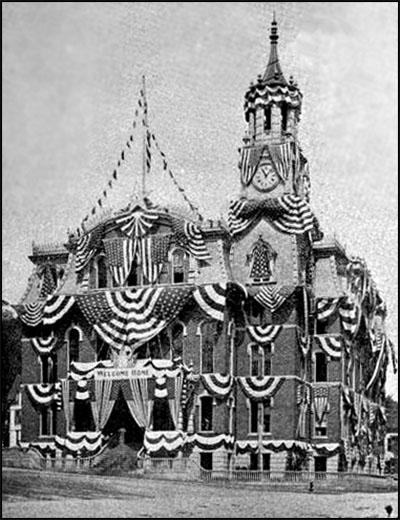
Norwich City Hall
On September 1-7 in 1901 Old Home Week was celebrated in Norwich in grand style. The Info Source provides a detailed account of the entire glorious event.
“NEVER within the two hundred and forty-two years that have elapsed since Major John Mason and his intrepid band of followers penetrated the wilderness and laid the cornerstone of the future city of Norwich, has this ancient and beautiful town felt the sense of elation and significance among the cities of Connecticut that was the rightful privilege of all her people during the first week in September, 1901 , which was set apart as the gathering time for present and past residents to congregate amid familiar scenes and renew the friendship of the years passed into history.”
The idea of the week was to welcome home former sons and daughters of Norwich who had been away from their friends and families who had remained in town.
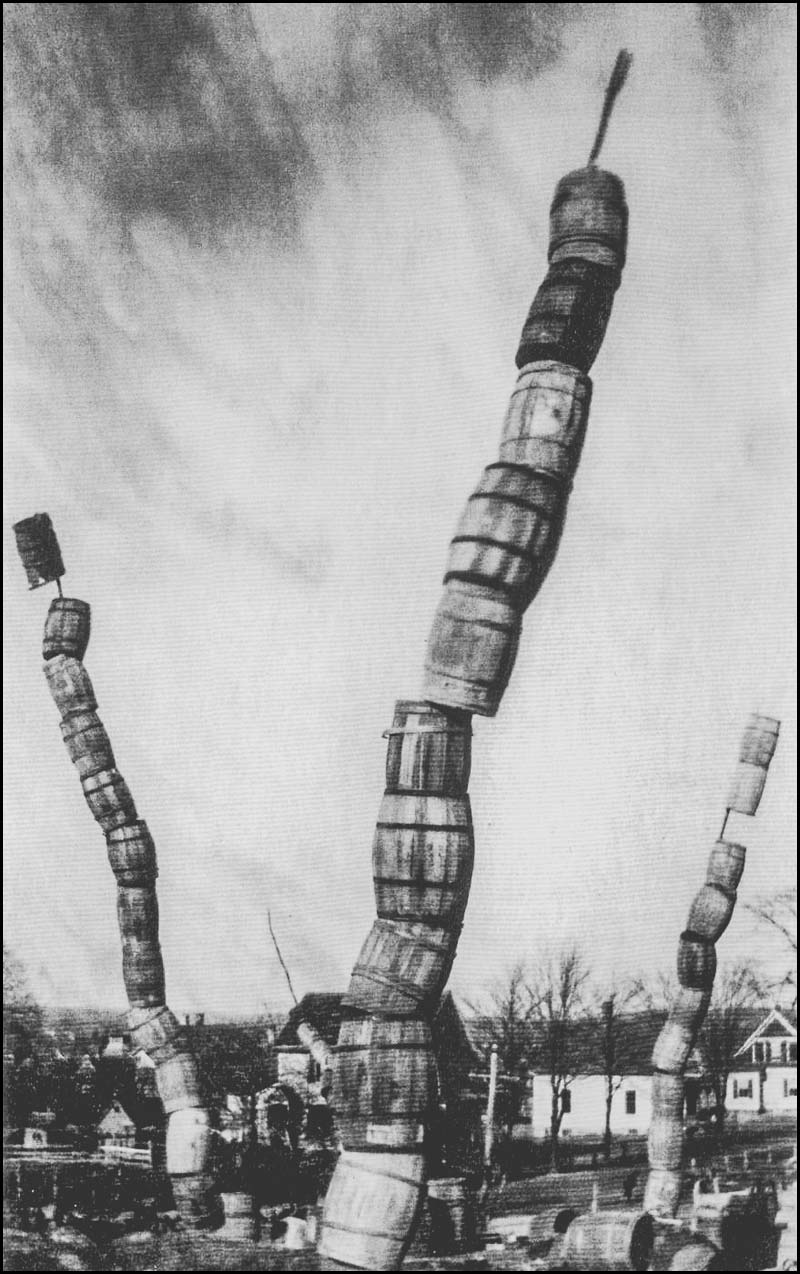
Mount Pleasant
On the Saturday night prior to Old Home Week a barrel bonfire was set ablaze on Mount Pleasant. The bonfire, featuring hundreds of burning barrels, acted as a welcome home beacon.
Many buildings in downtown were decked out in patriotic banners in readiness to receive the guest of honor, former President Grover Cleveland. His father was born in Norwich many years earlier.
Mayor Charles F. Thayer first came up with the idea to host an Old Home Week celebration in Norwich. After the Court of Common Council in Norwich approved the idea, Superior Court Judge John M. Thayer (Charles’ brother) and James B. Shannon (real estate developer) personally traveled to Massachusetts and invited former President Cleveland to be the guest of honor.
Many events took place over the week. There was a baseball game between Taftville and Jewett City, a tug-of-war contest, a horse race, the barrel bonfire, fireworks in the harbor, an evening dance and more. There was a “Norwich Town Loan Exhibit” in the old-school house on the Norwichtown Green. The exhibit featured many fine antiques, including a clock made by Joseph Carpenter and a clock made by Deacon William Cleveland (President Cleveland’s grandfather).
One of the first events of the week was the parade of antiques and horribles. (“Antiques and Horribles” is defined by Miriam-Webster as : fantastic impersonations forming part of a parade). The parade took place early on Tuesday morning. It formed on Market Street near the present-day court house and meandered throughout the town. However, this was only a warm-up parade.

On Tuesday evening President Cleveland arrived. The next morning President Cleveland was officially received by the Common Council. The Grand Parade began in afternoon at 2:00 pm.
More than 40,000 people attended. President Cleveland took a prominent position in the review stand in front of City Hall.

Gilt Edge Coffee Float
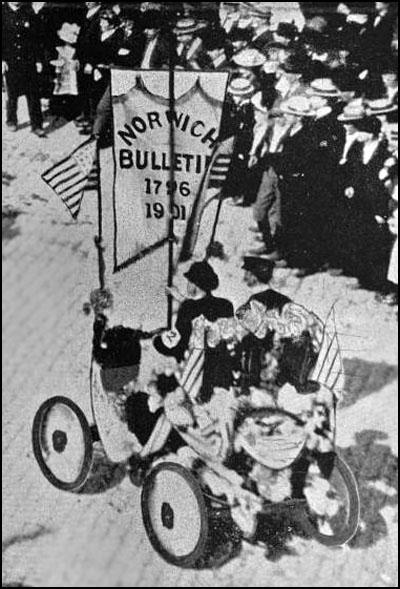
The photo on the left shows the Norwich Morning Bulletin’s handsomely decorated Locomobile. It was decorated with a beautiful display of hydrangeas. Locomobile was one of the earliest car manufacturers in America.
“The float of Henry Allen & Son was in excellent taste and showed the hand of a skillful designer, its elegant simplicity being very noticeable.”
Excerpt from Info Source 1
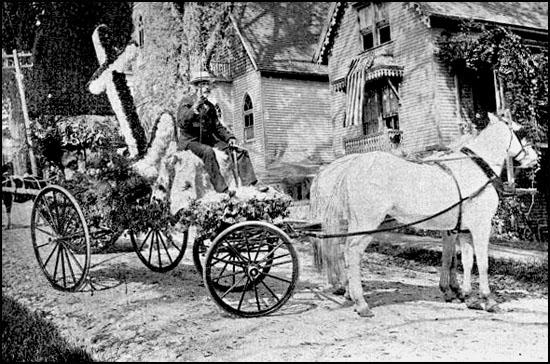
Floral Float
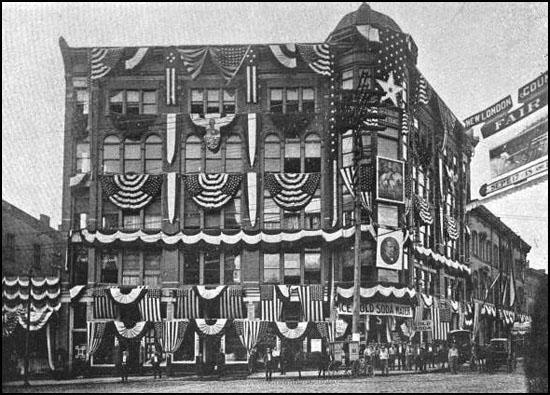
September 1901
The Shannon Building, shown in the photo on the left, is the original building constructed by “Big Jim” James B. Shannon, an Irish business man and real estate developer, in 1892. It was destroyed by fire in 1909, but, rebuilt the following year as a fireproof structure.
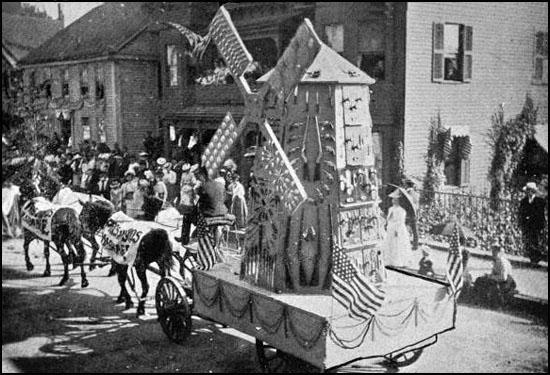
There were magnificent decorations throughout the town. The decorations that had been arranged by both merchants and residents in honor of the event surpassed in beauty and effectiveness of design any similar display in the history of the city.
All Norwich was in gala attire, and the appearance of the whole town was so bright and patriotic that it was an inspiration alike to the resident and to the stranger within the gates. Not a street but was radiant with the national colors, both flags and bunting, as well as many original designs that were alike unique and pleasing.
Acknowledgements
“Old Home Week, Norwich, Conn., September 1-7, 1901,” published by Bulletin Print
“Old Home Week, Norwich, Conn., September 1-7, 1901,” published by Bulletin Print
1903-1904 Horse Sleighing on Thames River
The Thames River can freeze over. During the winters of the early 1900’s Norwich residents enjoyed horse sleighing on the frozen Thames.
Acknowledgements
Otis Library
Otis Library
JULY 4-6, 1909 : NORWICH 250th ANNIVERSARY CELEBRATION
Union Square on July 5, 1909
*Place cursor over images to magnify
Eight years after Norwich’s celebration of Old Home Week, the town hosted, the 250th anniversary of its founding. It was a spectacular event that included a visit from President William Howard Taft.
Every building downtown was decorated with red, white and blue buntings, and it was said to be the most spectacular celebration in Norwich history.
Town Hall can be seen on the left and the original Broadway Congregational Church is shown on the right.
On Saturday, July 3, before the formal celebration began, several warm-up events took place at the New London County Fairgrounds on East Great Plain. The “Gentlemen’s Driving Club” sponsored a several horse races. Later in the afternoon a 6-round boxing match between Abe the Newsboy and Patsy Fenton. The dirigible California Arrow II was scheduled to fly, but there was too much wind.
On Sunday, July 4 commemorative services were held in every church. Norwich’s celebration was steeped in civic awareness, patriotic pride and spiritual connection. Gravesites at both the Norwichtown Cemetery and the Mason monument were decorated to show respect for Norwich founders and other former citizens. In the late afternoon a community service and organ recital was held at the Old Burying Grounds. The minister of the First Congregational Church, Reverend Frederick P. Gulliver, led the service. Reverend Dr. Lewellyn Pratt, addressed the congregation with a sermon entitled, The Founders Before They Came to Norwich. The service was concluded with the congregation singing America.
They probably sang America to the tune of Auld Lang Syne. The version of America sung at the gravesite was not the version that is sung today by millions. The combination of lyrics by Katharine Lee Bates and music by Samuel A. Ward were first published in 1910, at least six months after Norwich’s celebration. See the sidebar below.
AMERICA THE BEAUTIFUL
O beautiful for spacious skies, For amber waves of grain, For purple mountains majesties Above the fruited plain! America! America! God shed His grace on thee, And crown thy good with brotherhood From sea to shining sea!
America the Beautiful
The song, America the Beautiful, was based on a poem written by the professor, poet, and writer, Katherine Lee Bates, during an 1893 trip to Colorado Springs, Colorado. When she got to the top of Pike’s Peak, the view was so beautiful that it inspired her to write, “All the wonder of America seemed displayed there, with the sea-like expanse.”
She first published the poem in 1895. After making several revisions, she published the final version of the lyrics in 1913.
- For years after America the Beautiful was written, it was sung to popular or folk tunes that would fit with the lyrics; Auld Lang Syne was the most popular of these tunes.
- Today, America the Beautiful. is sung to Samuel A. Ward’s Materna.
U.S. Naval Academy Cadets Entering Norwich, July 5, 1909,
*Place cursor over images to magnify
Monday, July 5, 1909 started off with a bang. At sunrise a salute to the nation was heard at sunrise, and shortly thereafter the ringing of church bells could be heard throughout the city. At 10:00 Captain Baldwin’s dirigible began its first ascent over the East Great Plain.
One of the largest parades in the history of Norwich was held at 2:00 pm. Cadets from both West Point and Annapolis marched into Norwich.
A contingent of the Mohegan tribe also marched in this parade. Included among these were Emma Tyler Baker, Lydia Fielding, and Cynthia Fowler.
A grand display of fireworks was set off on Monday night. These fireworks were paid for using money saved from the 200th Anniversary, 50 years earlier.
Yantic Woolen Company Parade Float
*Place cursor over images to magnify
On Tuesday, July 6 at 9:30 an automobile parade took place. This parade included the float shown on the left that was entered by the Yantic Woolen Mill Co. Notice the sheep on the bottom portion of the float.
Later at 11:00 the Memorial Fountain, on Chelsea Parade, was dedicated, and then, at 11:30 the Putnum Phalanx dress parade took place.
There were activities scattered throughout Norwich on late Tuesday afternoon. The activities included a commemorative baseball game, a band concert, and a water carnival. A Grand Ball was held in the evening.
Many homes and businesses throughout Norwich were illuminated by electricity every night of the celebration. The most notable Illumination was held at the home of former mayor Frederic L. Osgood. He displayed hundreds of yacht flags in his Washington Street home’s yard.
“The Rose of New England: Norwich, Ct Celebrates the 250th Anniversary of Its Founding,” 1909, pp 430-441
Public Domain
Norwich Ct. Pictures, USA
Norwich Ct. Pictures, USA
The complete list of sources may be found by clicking the “Bibliography” button, and, then typing “Norwich 250th” in the SEARCH box.
1909 Dirigible Flies In Norwich
As a part of Norwich’s 250th Anniversary one of the first flying ships flew over the old fairgrounds in East Great Plain for several minutes. (Info Source #1).
It ascended over the fairgrounds twice on Monday, July 5, 1909 and twice on Tuesday, July 5, 1909.
Long before the notorious 1937 crash of the Hindenburg in New Jersey, Norwich’s anniversary merited its own “airship.” For a fee of $1,000 ($23,500 in today’s dollars), the California Arrow was engaged to “ascend” four times over the city and over the head of President William Howard Taft from a lot of 40,000 square feet. For admissions of fifteen cents ($3.50 in today’s dollars), its Captain, Thomas S. Baldwin of New York, lectured to visitors in a special tent. Proceeds returned to the Committee.
The postcard shown in the photo identifies the dirigible as the “California Arrow”. It is actually the Baldwin #9, christened as the “California Arrow II”. The first California Arrow was destroyed three years earlier on April 18, 1906 during the massive San Francisco Earthquake.
— from Info Source 3
Acknowledgements
“Norwich Celebration Promising,” 06/07/2009, by Bill Stanley
WelWeb.org
The complete list of sources may be found by clicking the “Bibliography” button, and, then typing “dirigible” in the SEARCH box.
1934 NORWICH 275th ANNIVERSARY CELEBRATION
On July 1st-4th, 1934 Norwich celebrated both the 150th anniversary of Incorporation of the City of Norwich and the 275th anniversary of its Founding of the Town of Norwich. The cover of the Official Program is shown on the left.
The celebration was similar to anniversary celebrations the past. There was a parade, exhibitions, a recognition of important sites and homes, a huge pageant, medals and ribbons for attendees and committee members.
The Norwich Sunday Record announced that 10,000 people were expected and that there would be “over 60 floats by business firms, societies, individuals, etc., over 10 bands and a number of drum corps”.
The opening ceremony of the 4-day celebration was held in the Broadway Theater on Sunday evening. Norwich Mayor, Edward G. Moran presided.
The Norwich Bulletin reported that : “Arriving visitors found a welcome extended in banners suspended over the highway on all the roads leading into the city. … Buildings on streets in the business section of the city were in festal array in decorations of bunting in the national colors and sidewalk flags will add to the gala effect. Many homes in residence section have also been attractively decorated for anniversary”.
Ode To Norwich
The “Ode To Norwich” was written in support of the celebration of 1934 Norwich Anniversary. The song was performed by the Norwich Choral Society at the opening ceremony of the 275th anniversary program.
The program was held on July 1, 1934 at the former Broadway Theater. This is the same building that was visited by Frank Sinatra in 1949, when he opened the Loew’s Poli Theater.
*Place cursor over images to magnify
The music for the song was written by H. Louise Fuller. She was the sister of the Norwich Art School Director, Charlotte Fuller Easton.The lyrics were written by W. Tyler Olcott. He had a peculiar fascination for various forms of verse. He composed several many sonnets, however, his first love was astronomy.
He was a renowned astronomer, who lived on Church Street in Norwich for almost his entire life. Olcott wrote five books on the subject and was highly regarded in the field. A crater on the Moon is named after W. Tyler Olcott.
Two other songs, “To The Future Inhabitants of Our Norwich Home” and “Two Hundred Years Ago, A Bi-Centennial Ode” which were composed for and sung at Norwich’s 200th Jubilee in 1859, were sung.
Acknowledgements
The complete list of sources may be found by clicking the “Bibliography” button, and, then typing “1934 Norwich Anniversary” in the SEARCH box.
1938 Hurricane of 1938
The photo shows Captain Howell of the Salvation Army lending a had on flooded Franklin Street. On September 21, 1938, the region suffered a monster hurricane. Tragically underestimated, the hurricane barged into the region with little warning, killing nearly 600 people in New England and destroying 9,000 homes and businesses and 2,600 boats.
*Place cursor over images to magnify
Packing a storm surge of 12-15 feet and winds of more than 120 mph, the Category 3 hurricane caused $400,000,000 ($7.3 billion in today's dollars) in property damage, according to the National Oceanic and Atmospheric Administration.
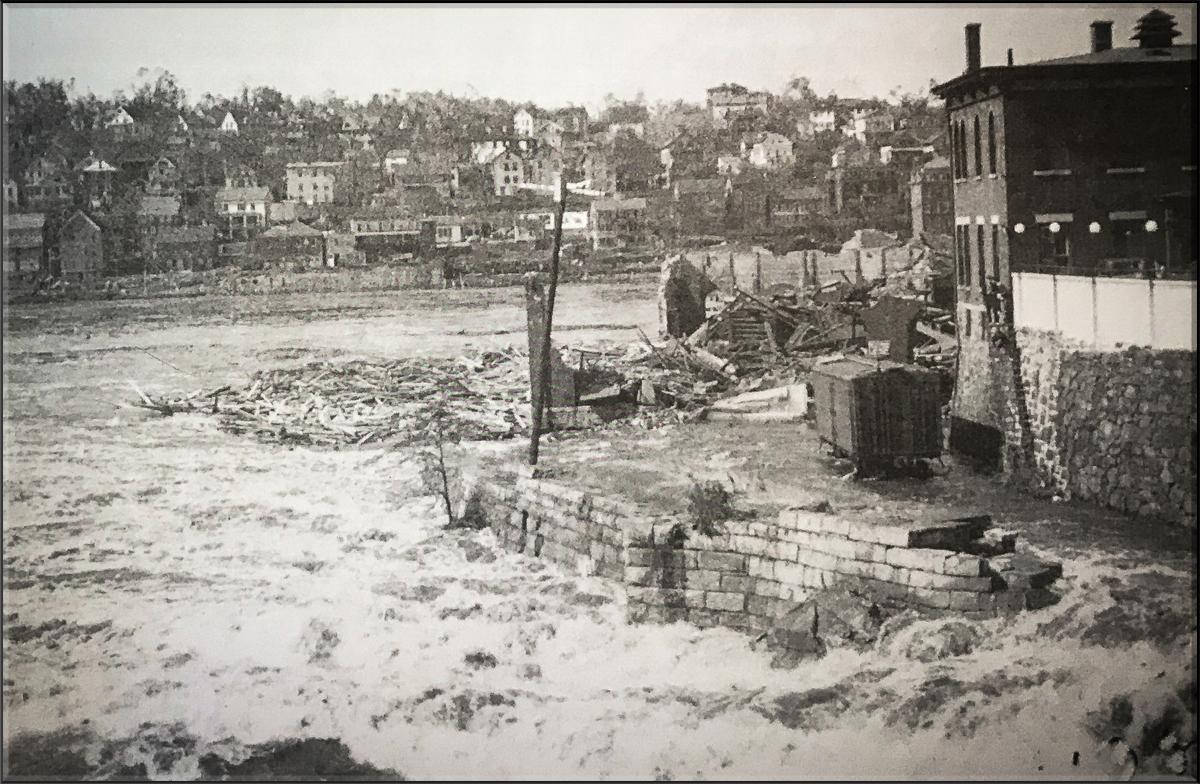
The Thames River flooded into Franklin Square and caused property damage across the region due to downed trees and branches and extensive flooding.
Acknowledgements
“Norwich Firefighters Use A Rowboat to Navigate Franklin Square,” 09/21/2008, by Bill Stanley
Photographed by Puza, 09/21/2008
The complete list of sources may be found by clicking the “Bibliography” button, and, then typing “hurricane” in the SEARCH box.
1947 Rose Garden Dedicated
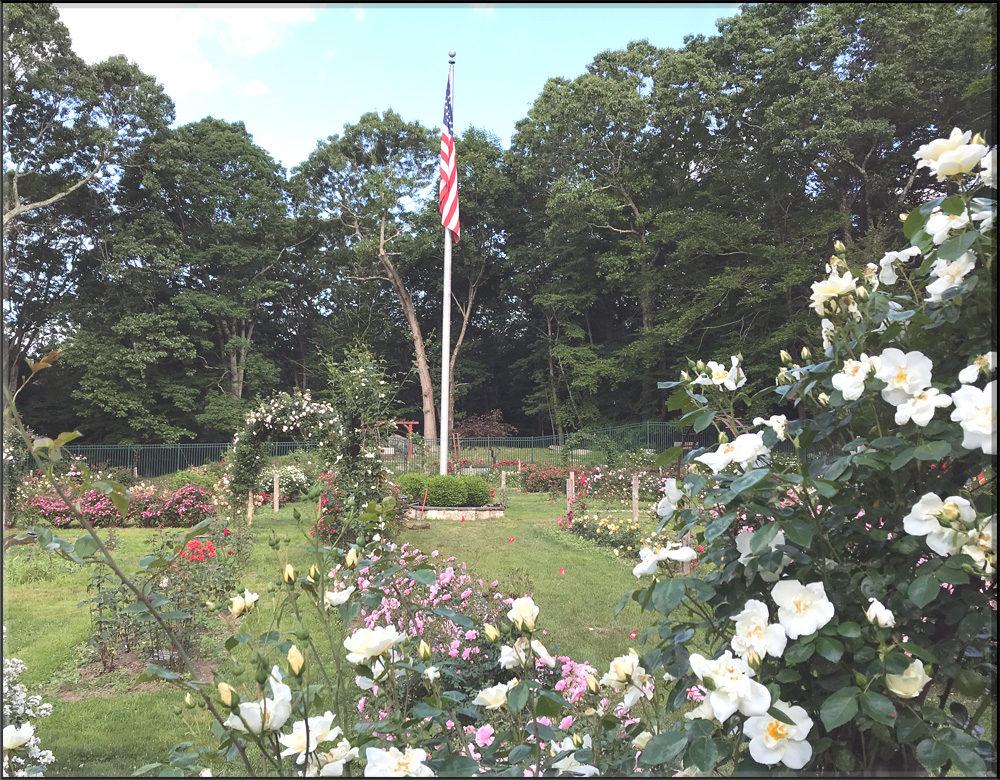
Veterans Memorial Rose Garden (also known as Mohegan Memorial Rose Garden) was dedicated in 1948 (and re-dedicated in 2008) to honor veterans of World War II
and has been maintained by the City of Norwich ever since. It is set on a half acre at the southern tip of Mohegan Park, a wooded city park full of trails, a swimming pond, and picnic areas.
A group of citizens led by Roy D. Judd in the 1940s determined that “The Rose City” should have a park befitting its name. They raised funds and hired Thomas H. Desmond, a landscape architect from Simsbury, to design the garden. Delayed by World War II , the rose garden was installed in 1947. Its first rose, “Lady Stanhope,” was planted April 16, 1947.
At the formal dedication ceremony, held on July 11, 1948, the Norwich Rotary Club officially transferred the garden to the City of Norwich. After receiving the garden for the City, Mayor Richard F. Marks was quoted in the Norwich Bulletin as saying : ”This garden is one of the most beautiful and restful spots in New England”.
In 2008, the garden was enclosed by a tall fence to protect it from browsing deer. Today the beds are bursting with 120 rose varieties and 1,250 rose bushes.
Until 2013 the garden was a trial site for “All American Rose Selections”, a California company that provided roses in exchange for feedback about how they performed until the company closed in 2013. Memorial donations made in honor of a loved one are used to purchase new plants, as evidenced by plaques in the rose beds, an indication of the many visitors who have enjoyed the beauty of this rose garden.
Acknowledgements
Connecticut Explored
Bob Dees
The complete list of sources may be found by clicking the “Bibliography” button, and, then typing “rose garden” in the SEARCH box.
1959 Norwich 300th Anniversary
In June 1959 Norwich celebrated the 300th Anniversary of its founding. The two-week event was a joyful affair that included a grand parade. The event was so successful that it was later, in 1965, used as a blueprint for the first Rose Arts Festival.
The Tercentenary Commemorative, plate shown on the left, was made in 1959. This Sabina Line collector plate highlights “The Rose of New England” and several historic buildings in Norwich.
*Place cursor over images to magnify
Pennants like these shown above were abundant throughout the city.
The photo on the left shows the front page of the Norwich Bulletin when Norwich celebrated its 300th Anniversary in 1959. It shows Major John Mason purchasing the nine-miles square from Uncas in 1659.
Residents of Norwich have a long history of celebrating its founding in a grand style. The 200th Anniversary Jubilee of the founding of Norwich was a two-day event that included a huge parade, a jubilee dinner hosting 2000 people in front of the Norwich Free Academy, and a formal ball. The 250th Anniversary Jubilee featured a parade with President William Howard Taft as a special guest. The 275th Anniversary celebration was a four-day event with more that 10,000 people lining the streets to witness a parade with more than 60 floats.
This photo, taken in 1959 by Bill Stanley, shows citizens of Norwich celebrating Norwich’s 300th anniversary, by spreading flakes of imitation gold on the pavement near Chelsea Parade. News of this event, the brain-child of Bill Stanley and his brother Jimmy, quickly spread nationally and internationally.
The “Norwich Street of Gold” article was on the front page of The London Times, The New York Times, and Time magazine. The United States’ most popular commentator, John Cameron Swayze, brought the “Camel Caravan” to Norwich.
Acknowledgements
“Norwich Celebration Promising,” 06/07/2009, by Bill Stanley
Courtesy of Jo-Ann Todd
WikiMedia
The complete list of sources may be found by clicking the “Bibliography” button, and, then typing “300th” in the SEARCH box.
1963 Spaulding Pond Dam Collapse
*Place cursor over any image to magnify
Mohegan Park and Spaulding Pond have been a place of tranquility and pleasure for more than a century. The Spaulding Pond Dam has kept the water in place for more than fifty years. The postcard shown of the left shows how the pond appeared in the fall of 1957.
The winter of 1962-1963 was severe and by early March heavy rains were melting a layer of glacial ice that was two-feet thick in places. On the afternoon of March 5 personnel from the City Public Works Department inspected the dam, looking for leaks. There was a concern for the safety of the dam because seepage had been observed in previous years.
View of dam and arbor (circa 1913)
*Place cursor over any image to magnify
Inspectors found that water was seeping through the dam’s earthen core. The director of the Public Works personally inspected the dam at 6:15 pm and confirmed there indeed was leakage. However, he saw no trace of erosion or other conditions symptomatic of imminent danger.
Unfortunately, his assessment was erroneous. Only a few short hours later, at 9:20 pm he contacted the Norwich police and informed them that the dam might collapse. At 9:25 pm a local radio station was contacted and requested to broadcast a city wide alert. At 9:27 pm the dam collapsed and sent a wall of water racing toward downtown Norwich.
The postcard shown on the left was postmarked in 1913.
*Place cursor over any image to magnify
On the crest of the wave were huge blocks of ice that worked like battering rams. Many of the blocks were that size of a kitchen table and were two-feet thick.
A local newscaster reported that the water in Franklin Square had been as much as five feet deep. Bill Stanley wrote : “The water on Bath Street and behind the Norwich Bulletin was like a huge lake”. The photo, shown on the left, was taken near Franklin Square in front of the Turner and Stanton Twine Mill.
At 10:14 pm several workers at the mill, unaware of the mortal danger that they were in, rushed upstairs to a window to see what all the commotion was about. A few moments later a 12-foot wall of water and ice washed away the lower floor of the mill.
Madeline Atterbury, Helen Roode, Alexander Pobol, Anna Louise Barrett and Mae Caroline Robidou all lost their lives as the mill collapsed.
Memorial to the Six Who Perished
Dedicated March 4, 2006
Several blocks north of Franklin Square, Ron Moody arrived home from work and warned his wife and family of the immanent danger. After telling them to evacuate his wife, Honey, gathered up their three sons to take them to her mother’s home in the western part of town.
The entire family, and their upstairs neighbor Tony Orsini, got into their car and Ron began driving. Just as they passed the Lake Street playground floodwaters floated their car off the road. Everyone made it safely out of the car but Honey. After she handed her infant son through the window to her husband, the car shifted and Honey was swept away into the freezing water. There was no chance for anyone to save Honey. She was found dead the next day 20 feet from the car.
*Place cursor over image to magnify
The failed dam was originally built in 1853 by two businessmen and was later modified. The dam was used strictly for providing a controlled water supply to downtown Norwich. The water was needed to power waterwheels for local businesses. Virtually no safety factors were built into the design of the dam. Its failure was attributed to bad design, poor maintenance and no consideration of its potential harmful impact to the city.
Following the investigation and a restructuring of the town’s emergency response organization, the Spaulding Pond Dam was rebuilt. The demolition of the old dam’s remains began in August of 1964, and the large modern replacement dam being completed and dedicated in September of 1965.
The new dam was mostly funded by the U.S. Department of Agriculture’s Soils and Conservation Service. It was built in accordance with the Watershed Protection and Flood Prevention Act of 1954. Today, it is a safe, well-maintained structure.
Acknowledgements
“A Swift and Deadly Maelstrom ; The Great Flood of 1963,” by Thomas Moody
“6 Died When Dam Bursts, Norwich Flooded,” 02/28/2010, by Bill Stanley
PicClick UK
Public Domain and Bruce Noland
The complete list of sources may be found by clicking the “Bibliography” button, and, then typing “Spaulding Dam” in the SEARCH box.